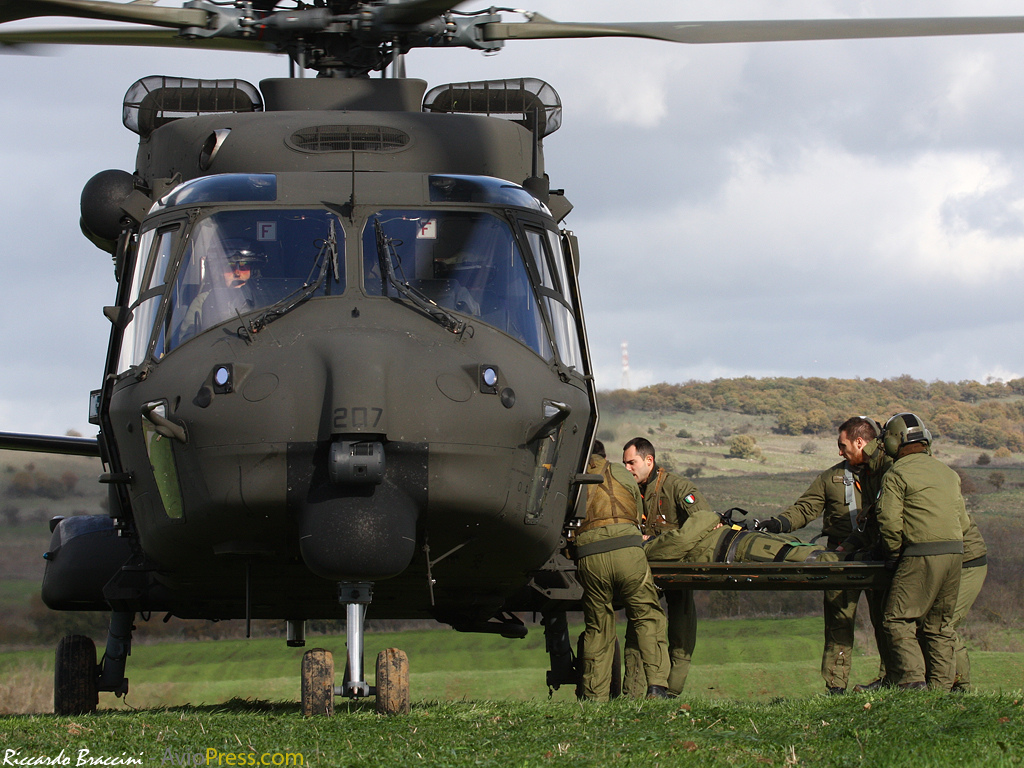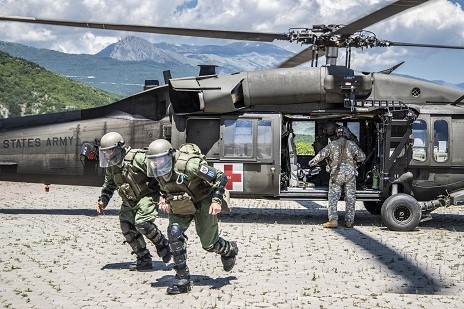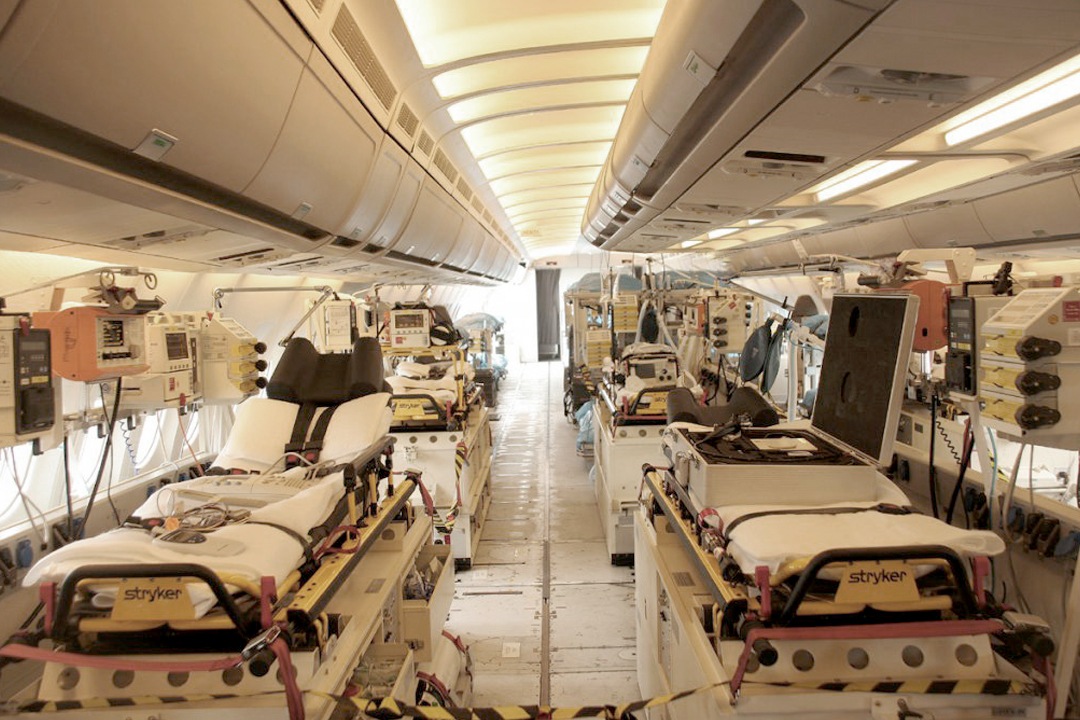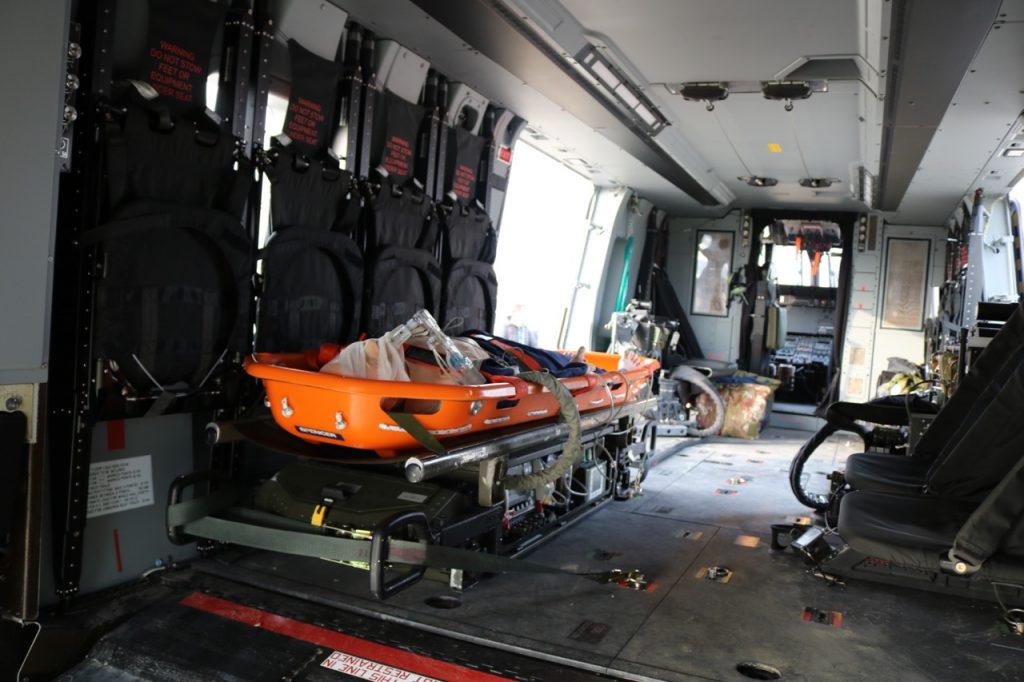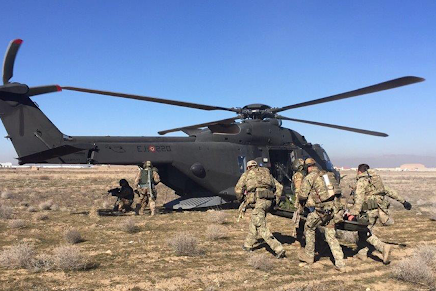
MEDEVAC with Italian Army helicopters
Medevac of the Italian Army: how medical evacuation works in operational theatres
Unlike wartime warfare, which we have been accustomed to studying in history books, today’s operational scenarios are characterised by a low level of conflict, albeit creeping and insidious.
Unlike the Second World War, today there is no concept of front and rear, but there is a condition called Three Block War, i.e. a situation in which military operations, police operations and humanitarian support activities for the population can occur simultaneously within a nation.
A consequence of these so-called asymmetrical conflicts, given the qualitative and quantitative disproportion between the contenders, is the dispersion of military units across the territory.
The operational area where the 4,000 Italian military personnel and the other 2,000 under our command from various nations operate is as large as the north of Italy, where no less than 100,000 members of the police force operate.
Our military personnel dispersed on Afghan territory refer to a medical evacuation chain based essentially on a system of helicopters and aircraft, which seeks to minimise the inconvenience caused by the long distances between the places of injury and the places of assistance.
Italian Army, MEDEVAC (Medical Evacuation)
This is the technical military term used to define a series of actions aimed at evacuating the wounded from the battlefield or, to be more faithful to current reality, from the area of operations.
This term is often mistaken for CASEVAC (Casualties Evacuation), i.e. the evacuation of wounded personnel using unplanned means.
In the current Afghan scenario, the medical evacuation chain must, at least for the most serious cases, be linked to the use of rotary wing vehicles, as it would be unthinkable to manage the ordinary transport of traumatised persons on Afghanistan’s impassable roads.
In fact, in addition to the disruption of the road network, the distance between the Medical Treatment Facilities (MTF) scattered throughout the area of operations must also be taken into account.
This is a fundamental element of difference between the medical interventions carried out on the national territory and what happens in the operational theatres.
On the national territory, an individual can be cleared to the reference hospital in terms of minutes, while in the Operational Theatre just the simple journey, although carried out by helicopter, can take hours.
To cope with these needs, the health support system is based on two components, one ‘lay’ and one ‘medical’.
Lay people are trained through Combat Life Saver, Military Rescuer and Combat Medics courses, the first two of which are similar to simple BLS and BTLS courses, while the third, lasting three weeks, is held at the Special Forces School in Pfullendorf, Germany, where experts in military emergency medicine teach more in-depth manoeuvres.
With increasing intensity, these courses provide riflemen, conductors, artillerymen and other military personnel with the necessary knowledge to be able to intervene in support of fellow soldiers, as a prerequisite for the intervention of specialised personnel; the aim is to intervene, albeit in a summary manner, within the golden hour.
The aim is to intervene, albeit in a summary manner, within the golden hour. In practice, the use of these figures has proved to be greater than expected, and has proved decisive in at least two verified episodes in the last two years.
Once the medical evacuation chain has been activated, while the lay person carries out basic life-saving manoeuvres, military health corps personnel or, alternatively, other medical units from allied countries intervene.
In particular, the MEDEVAC service carried out with rotary wing units is implemented on a rotational basis by different nations which, in the division of tasks and forces on the ground, have been assigned this task.
Read Also: Safety In Medevac And Hems Of Healthcare Workers With Routine Dpi With Covid-19 Patients
MEDEVAC ACTIVITY WITH THE ITALIAN ARMY HELICOPTER
The most effective activity of MEDEVAC missions is the one carried out with the aid of dedicated aircraft, in order to have the quickest possible evacuation; obviously, in order to have a quality intervention, it is necessary that the medical personnel have received specific training in aerial intervention and that the medical equipment is compatible with transport and use in flight.
The Army Aviation (AVES) has had the task of coordinating all the Army’s resources aimed at training a medical flight crew according to NATO’s Standardization Agreements (STANAG) and to the standards required by national regulations.
In fact, the Army had all the necessary resources, but lacked the necessary amalgam to be defined in no uncertain terms as a MEDEVAC service as required by NATO standards.
The coordination activity of the Army Aviation was aimed not only at creating an ad hoc team for the Afghan or Lebanese requirement, but also at creating a permanent system of training and management of medical flight crews identifiable in the “MEDEVAC Pole of Excellence” created at the AVES Command in Viterbo.
CANDIDATES FOR THE MEDEVAC TEAM
The personnel selected to be part of the MEDEVAC team of the Italian Army must, first of all, be physically fit for flight service, which is ascertained by the Air Force Medical Legal Institute, because as a crew member they must operate and interact at any time during the flight mission with precise responsibilities.
The flight training part is carried out at the Centro Addrativo Aviazione dell’Esercito (CAAE) in Viterbo, where the “Forward MEDEVAC” course has been set up, aimed at making medical personnel become flight crew.
The subjects covered are purely aeronautical, and the only medical part is aimed at familiarising students with the specific medical systems used on Army Aviation aircraft, as well as with patient management policies based on available resources and possible intervention scenarios.
The trainees are highly qualified, motivated and, as always when it comes to flight crews, voluntary medical and nursing personnel, coming from three areas: the “critical area” of the Policlinico Militare Celio, medical personnel of the AVES bases and ordinary and selected reserve personnel working in the emergency sector.
The need for MEDEVAC crews is to have medical personnel specialised in pre-hospital intervention activities, a characteristic that medical personnel on duty at AVES bases must achieve through on-the-job training that includes Advanced Trauma Life Support (ATLS) and Pre-Hospital Trauma Life Support (PHTLS) courses, as well as internships at suitable clinical facilities.
The reserve’s anaesthetist/resuscitation personnel are a valuable asset as, coming from the civilian world, they are better trained in emergency operations than military personnel.
In addition to the flight crews, there are also troop graduates with the post of Health Assistant (ASA), a military professional figure that has recently been given increasing technical importance, similar to the rescue volunteer but potentially improving over time.
The subjects covered in the course include basic notions of helicopter flying and its operational use, aeronautical terminology, use of primary and emergency on-board intercom systems, loading capacity of Army Aviation helicopters, embarkation and disembarkation procedures, flight safety and accident prevention, meteorology, survival and evasion and escape in the event of a crash in hostile territory, emergency procedures, familiarisation with NVG systems and the electro-medical equipment of the STARMED® PTS (Portable Trauma and Support System).
The activity is very tightly packed into two weeks, so the practical lessons sometimes run continuously until late at night, especially the night boarding and disembarking or survival activities.
The weeks are divided into a theoretical and a practical week, and it is in the latter that the students carry out most of the flying, marching after ‘shooting down’ and other activities where they need to ‘get their hands on’ rather than study.
Read Also: Italian Military Aircraft Provided A MEDEVAC Transport Of A Nun From DR Congo To Rome
MEN, MEANS AND MATERIALS IN MEDEVAC
Once the operators have been trained, they form MEDEVAC teams of 6 men, divided into two 3-man crews, with the possibility of reshuffling in cases of extreme necessity.
Under normal conditions, the crews operate as far as the aircraft payload allows, with one doctor and one nurse, at least one of whom belongs to the critical area, and a supporting ASA.
In case of absolute necessity or in case of a mass casualty (MASSCAL) a crew can intervene even undersized or subdivided to increase the number of MEDEVAC aircraft.
Each crew has a double set of equipment, a backpack and a fixed set based on the STARMED PTS system, as well as various combinations of the two depending on the mission profile.
THE ITALIAN ARMY AVIATION HELICOPTER FLEET
The Army Aviation has the largest fleet of helicopters of all the armed forces and, therefore, the MEDEVAC team must be trained to operate all machines available for combat support.
The most complex machines, due to the limited space available, are the AB-205 and B-12 series multi-role helicopters, inside which the crew and the PTS STARMED stretcher find a place, but without too many luxuries; on the other hand, inside the NH-90 and CH-47 there is the possibility of embarking more than one crew/PTS system.
The PTS STARMED system is a modular system for the transport of medical and wounded equipment, developed on behalf of the German Armed Forces, adaptable to a range of land, sea and air vehicles, and adaptable to any system/vehicle that meets NATO standards.
In particular, the PTS can be configured/customised by medical personnel with different electro-medical equipment and, if necessary, it can be loaded and unloaded in conjunction with the stretcher with the patient.
The ability to have medical equipment ergonomically available on board helicopters is a very strong need in the military sector.
Civilian helicopters dedicated to helicopter rescue have specific equipment that makes the machine suitable for the task.
Unfortunately, in the military sector it is not possible to dedicate a machine to an exclusive task for different reasons; firstly, it must be considered that military machines are deployed in an operational theatre according to the mission profile they have to carry out and according to the logistic support available, secondly, according to the availability of flight hours, there is the need to move machines from one mission profile to another, and finally, it must always be taken into account that the MEDEVAC helicopter could be damaged.
For example, it is well known that the Lebanese theatre of operations is equipped with B-12 series machines; having a MEDEVAC exclusively mounted on another type of machine would mean two logistics lines.
The need for a kit that could be quickly transferred from one helicopter to another led the SME IV Department Mobility Office to identify the PTS stretcher produced by the German company STARMED and marketed by SAGOMEDICA, which had already tackled the problem on behalf of the Bundeswehr, the German Armed Forces.
The PTS was considered suitable for the needs of the Army Aviation to quickly equip its helicopters dedicated to medical evacuation; in fact, the most evident feature of the PTS is that it fits on the NATO supports for stretchers.
The PTS consists of 5 main parts:
- main container;
- instrument tray;
- conventional stretcher;
- spine/toboga board;
- electromedical equipment.
The main systems supplied to the PTS chosen by the medical staff and purchased by the Army include, Argus multi-parameter defibrillator monitors, Perfusor pumps, video laryngoscopes, high-tech but easy-to-use Medumat transport ventilators, and 6-litre oxygen cylinders.
Alternatively, there is also a range of backpack transportable equipment (including a small Propaq multi-parameter monitor, an emergency oxygen ventilator, and all airway management and infusion equipment) of a more compact size that can be used in situations where personnel need to be disembarked and isolated from the PTS system.
The PTS system makes it possible to assist the patient throughout the entire clearance chain; in fact, thanks to its modularity, the system can also be configured for strategic transport, i.e. long journeys.
Although the chosen medical equipment was guaranteed for use in flight, the Army Aviation had to carry out a long campaign of tests, aimed at obtaining operational certification, i.e. full compatibility of the medical equipment with on-board equipment in order not to create interference, both electromagnetic and mechanical.
This also includes on-board monitoring/defibrillation tests on the various aircraft models using the Argus Pro Monitor/Defibrillator, which is now the most compact model in its category, with robustness and safety features that are well suited to military operational flight, while retaining all the necessary technical characteristics.
The aforementioned tests have entailed further work for the Army’s aeronautical technicians, also due to the sophisticated self-protection equipment against thermal search and radar-guided missiles.
INTERVENTION METHODS
The system for clearing the wounded on the battlefield is organised on a series of MTFs deployed in the area of operations, with increasing capacity as one moves away from the combat zone. In fact, like most NATO procedures, MEDEVAC was designed to operate in a conventional European theatre of operations with opposing parties, which is not exactly suitable for the Afghan theatre.
When a patrol on the ground comes under fire and suffers casualties, a 9-line message is sent, encoding nine pieces of information that are important for organising rescue operations.
At the same time, Combat Lifesavers begin life-saving manoeuvres on the stricken soldier and prepare him for rescue by the Forward MEDEVAC team.
At the heliport, armed escort helicopters and two clearing helicopters prepare to intervene.
The A-129 helicopters are the first to arrive at the site of the firefight, trying to eliminate the enemy source with 20mm cannon fire; once the area has been secured, the MEDEVAC helicopters intervene, one of which is the main platform and the other acts as a reserve or to clear walking wounded, among whom may be soldiers suffering from post-traumatic stress.
If there is particular resistance from the adversary, the giant CH-47 transports also intervene, each carrying 30 soldiers who can disembark to reinforce the ground unit.
It may seem strange that six helicopters and 80 pilots and soldiers are involved in a medical operation, but this is the reality in Afghanistan.
At this point, the wounded person travels backwards towards the casualty collection point, ROLE 1, which is the first link in the clearance chain and, if it is not deemed suitable for treating the wounded person, he is moved to the next MTF, ROLE 2, which has resuscitation and surgical capabilities, and finally to ROLE 3, where operations of particular complexity requiring a real hospital structure are carried out.
Unfortunately, the reality of today’s operational theatres does not involve a linear deployment with mobility of systems from the front to the rear, but, on the other hand, a scattered patchwork of FOBs, check points and patrols that move continuously through impervious territory, which in part nullifies the ROLE concept.
The US Forward Surgical Team system aims to move resuscitative and surgical expertise from ROLE 2 to ROLE 1 in order to shorten the clearance chain and intervene more and more within the golden hour.
The Italian Army’s Forward MEDEVAC system consists of a pre-positioned system of air assets in an area where it is believed friendly forces may come into contact with the adversary or where hostile activity against the contingent is suspected.
The pre-positioning of rescue vehicles makes it possible to move patients directly to the most suitable MTF for the treatment of the wounds received.
It goes without saying that the vast area of responsibility, the long flight distances to reach a possible casualty, the complexity of the scenario (which may not allow a stabilization in a safe area for a long time and in wide spaces), the distances to be covered to reach the MTF most suitable for the treatment of the patient and the high technology of the equipment available, require an uncommon skill for the medical flight crew employed for the Forward MEDEVAC of the Italian Army.
Other uses of MEDEVAC helicopters may include barycentric positioning in order to intervene throughout the theatre of operations, but with longer timescales, which is defined as Tactical MEDEVAC, while sending the patient home with fixed-wing aircraft is defined as STRATEVAC (Strategic Evacuation), such as Falcon or Airbus.
ITALIAN ARMY MEDEVAC, CONCLUSIONS
The Army is the Armed Forces that, in missions abroad, has paid, and is paying, the highest toll in terms of human lives and injuries; in fact, the particular activity of counter insurgency and all related aspects, such as mine clearance and CIMIC activities, provide an overexposure of personnel to the risk of injury.
In this sense, the Italian Army wanted to frame the MEDEVAC team in the most complete and cutting-edge way possible, both in terms of materials and in terms of skills and procedures.
To this end, the Forward MEDEVAC team of the Italian Army, based on AVES aircraft, is the epitome of the best available, not only in the Armed Forces, but also in the national context.
The medical equipment combined with exceptionally high-performance flying platforms provide highly qualified medical personnel with a device that is hard to find in other countries.
The rotary wing vehicles have proved to be fundamental in all forms of activity of the ISAF contingent, whether of a distinctly military nature or purely logistical support to the population, so it was impossible not to refine materials, men, means and procedures to achieve the best also in the field of medical support to military operations.
At present, the MEDEVAC team operates with the aircraft of the Italian Aviation Battalion as a back-up to the Spanish airborne medical device in support of the operations of Regional Command West (RC-W) in Herat.
READ ALSO:
COVID-19 Positive Migrant Woman Gives Birth On The Helicopter During A MEDEVAC Operation


